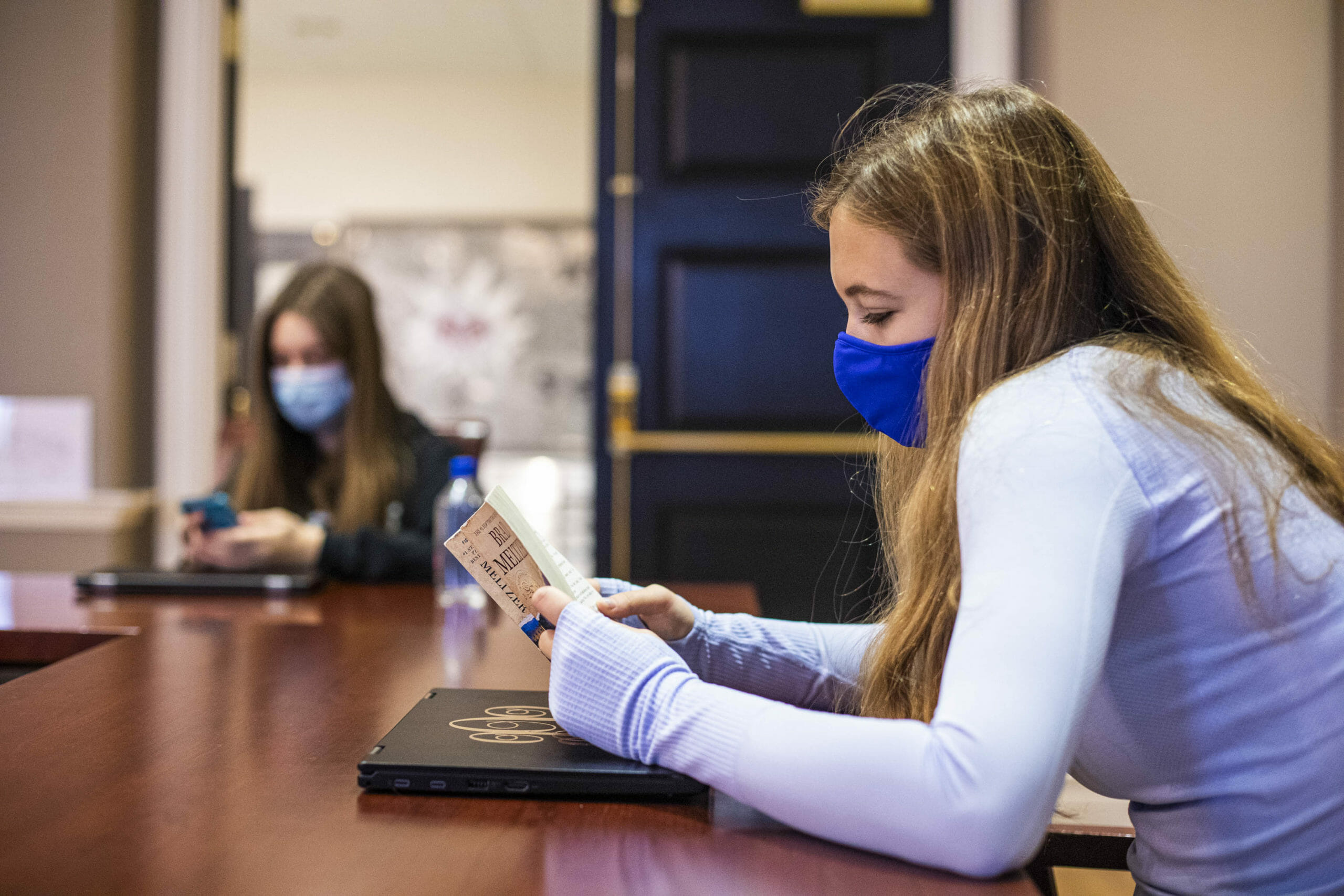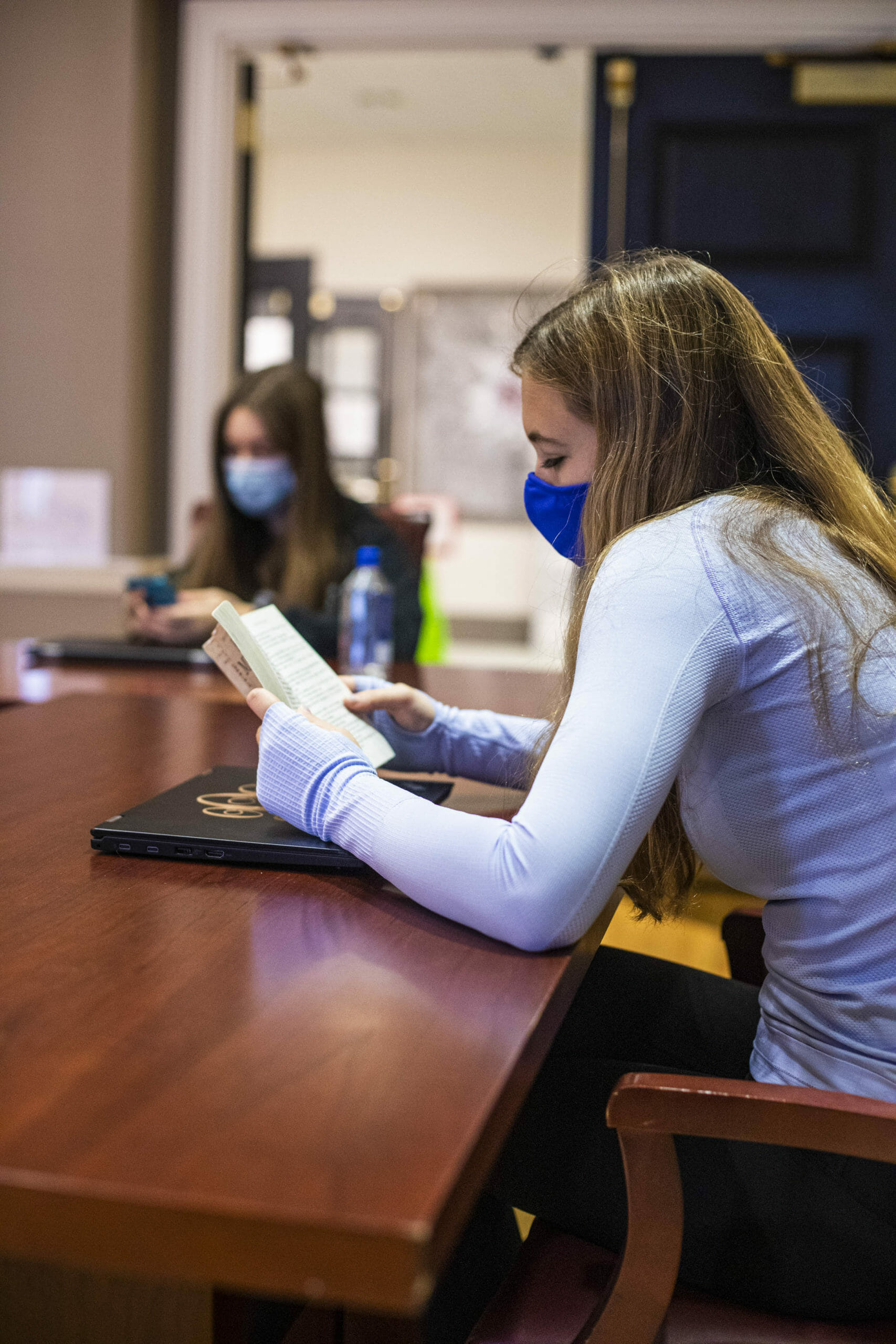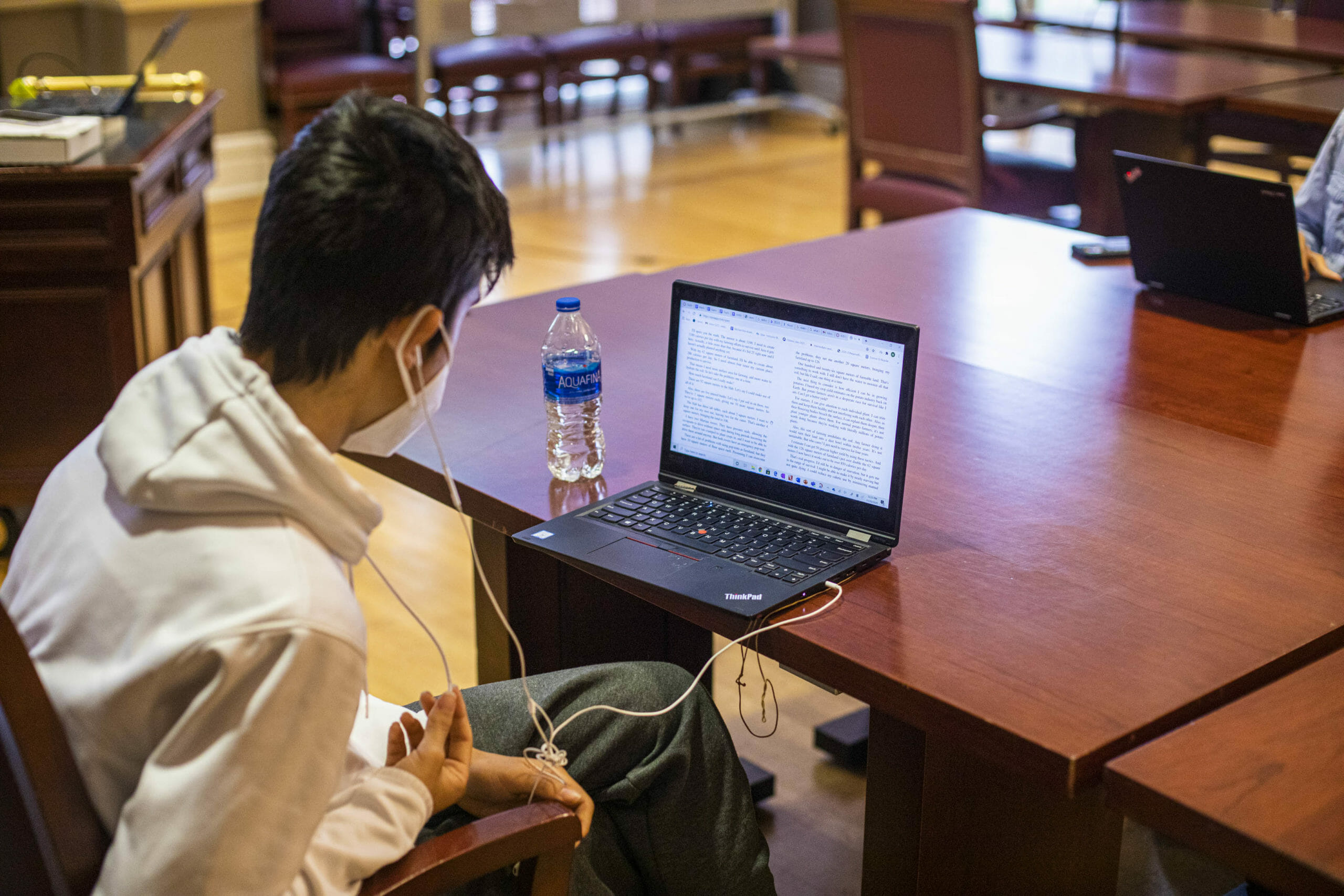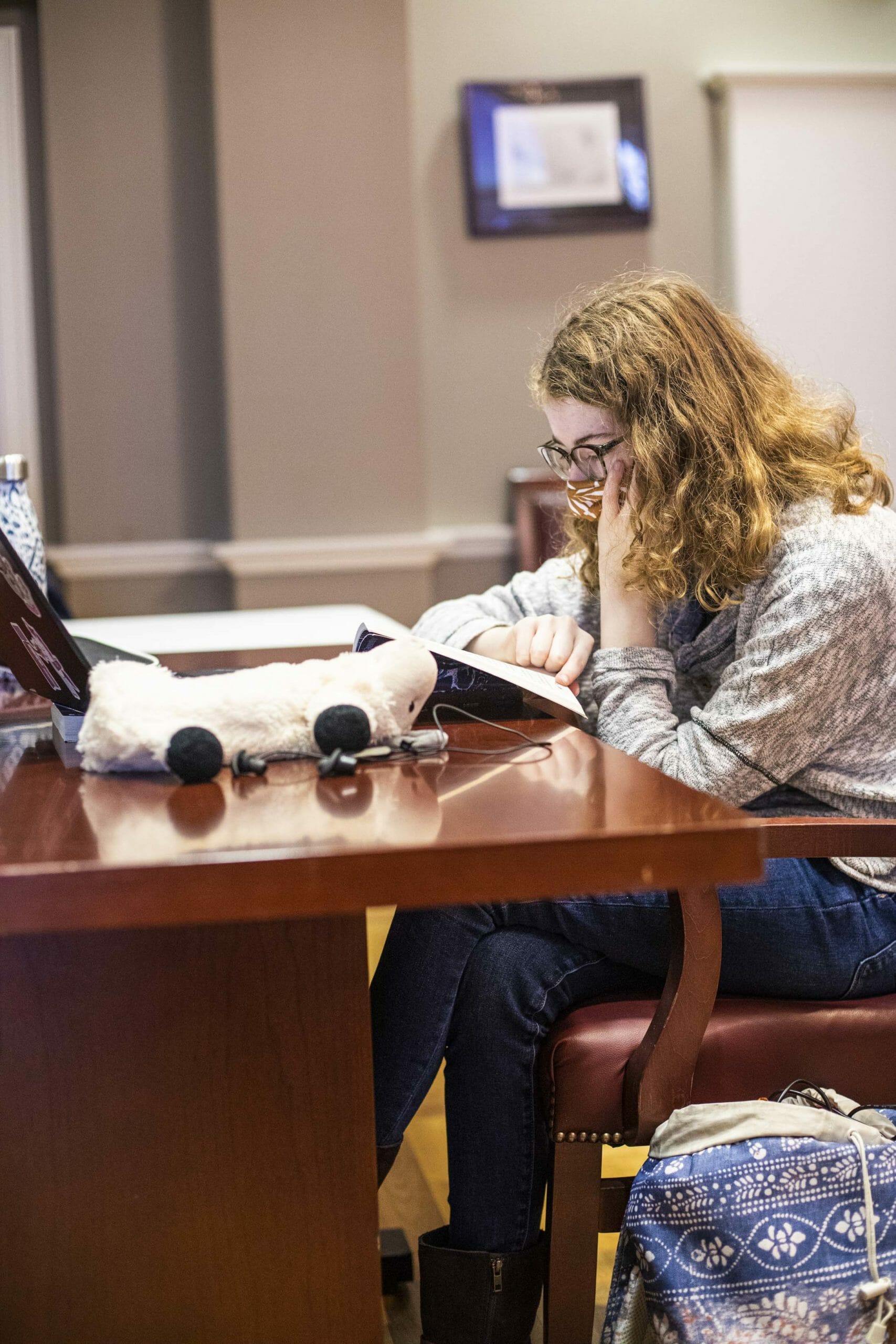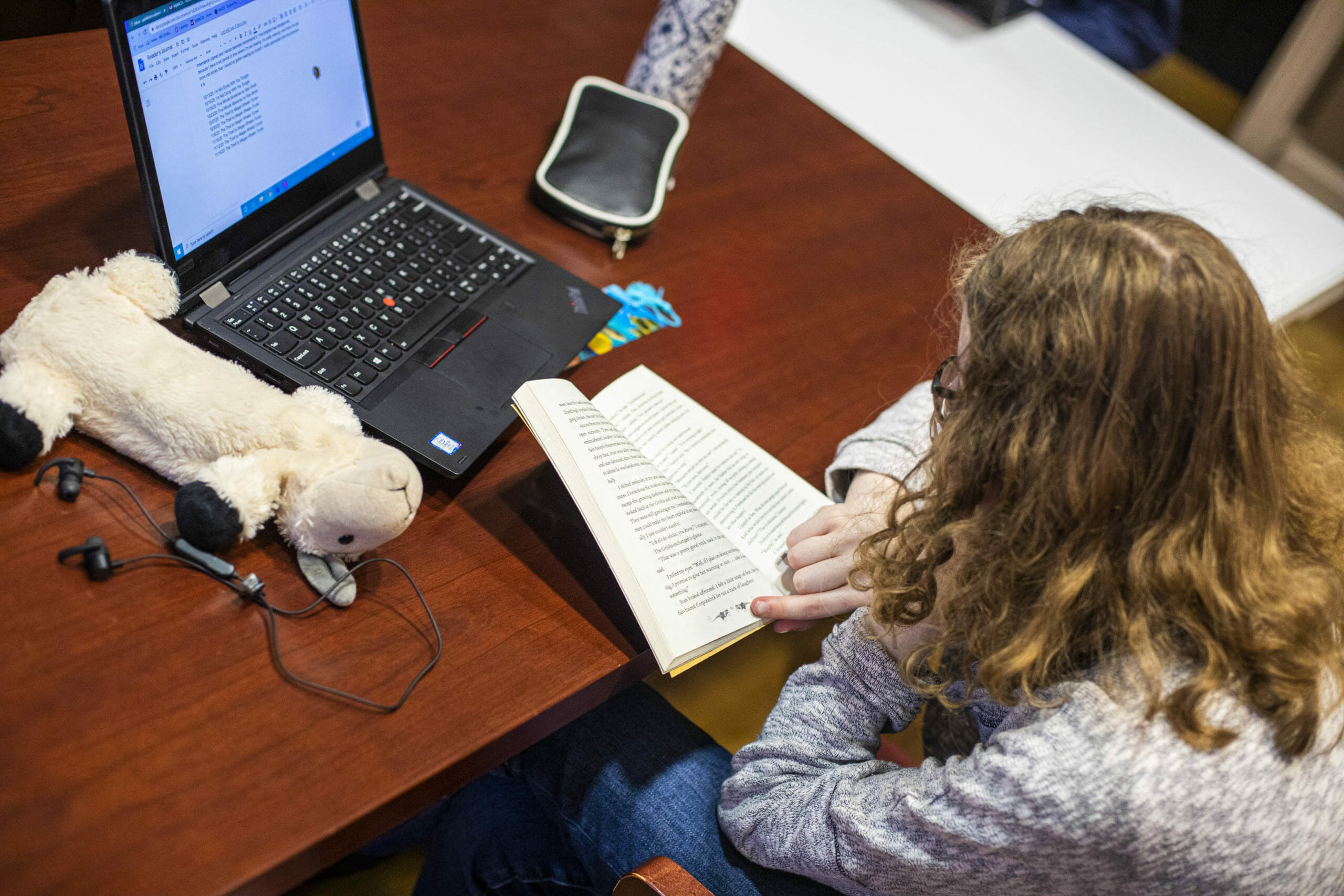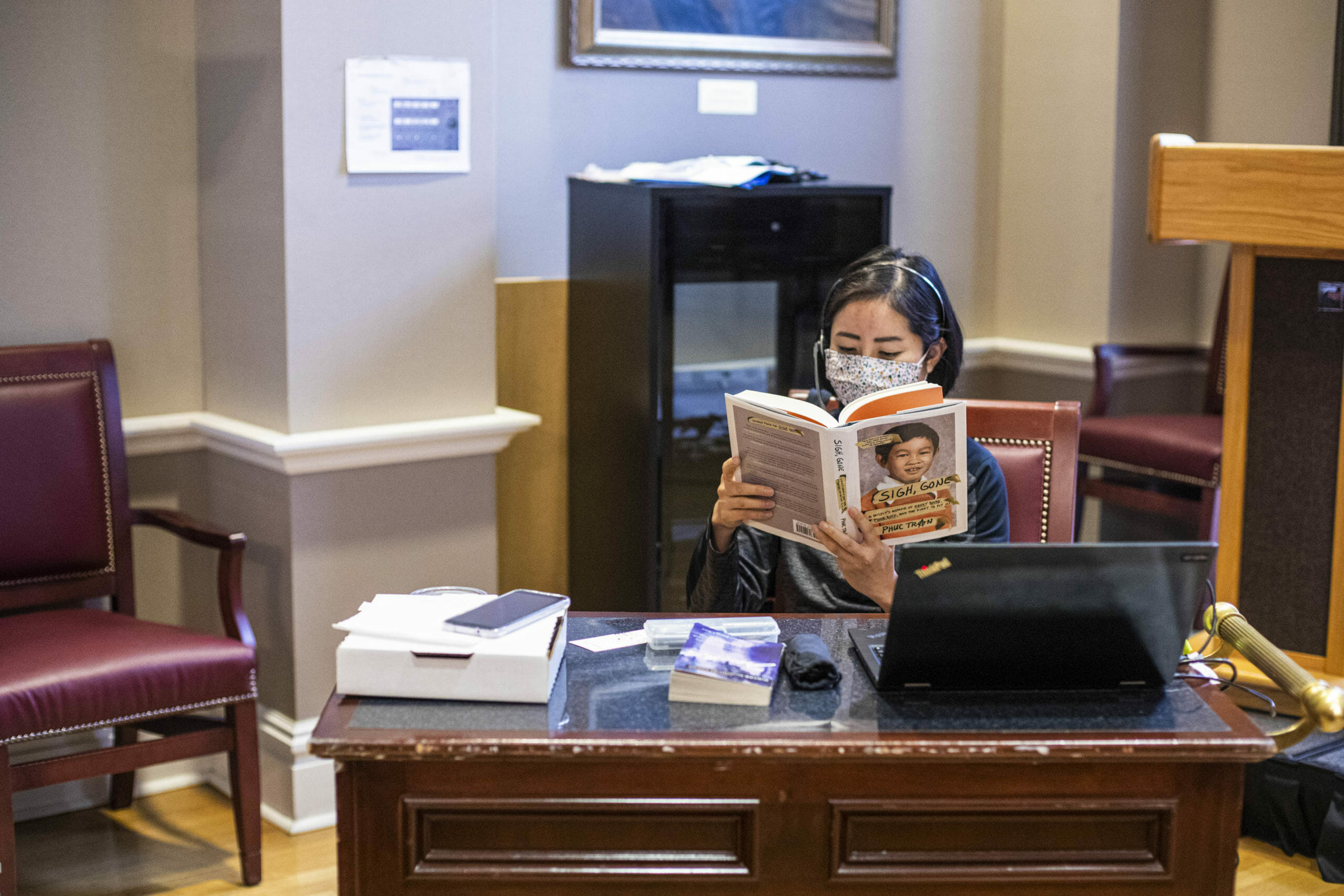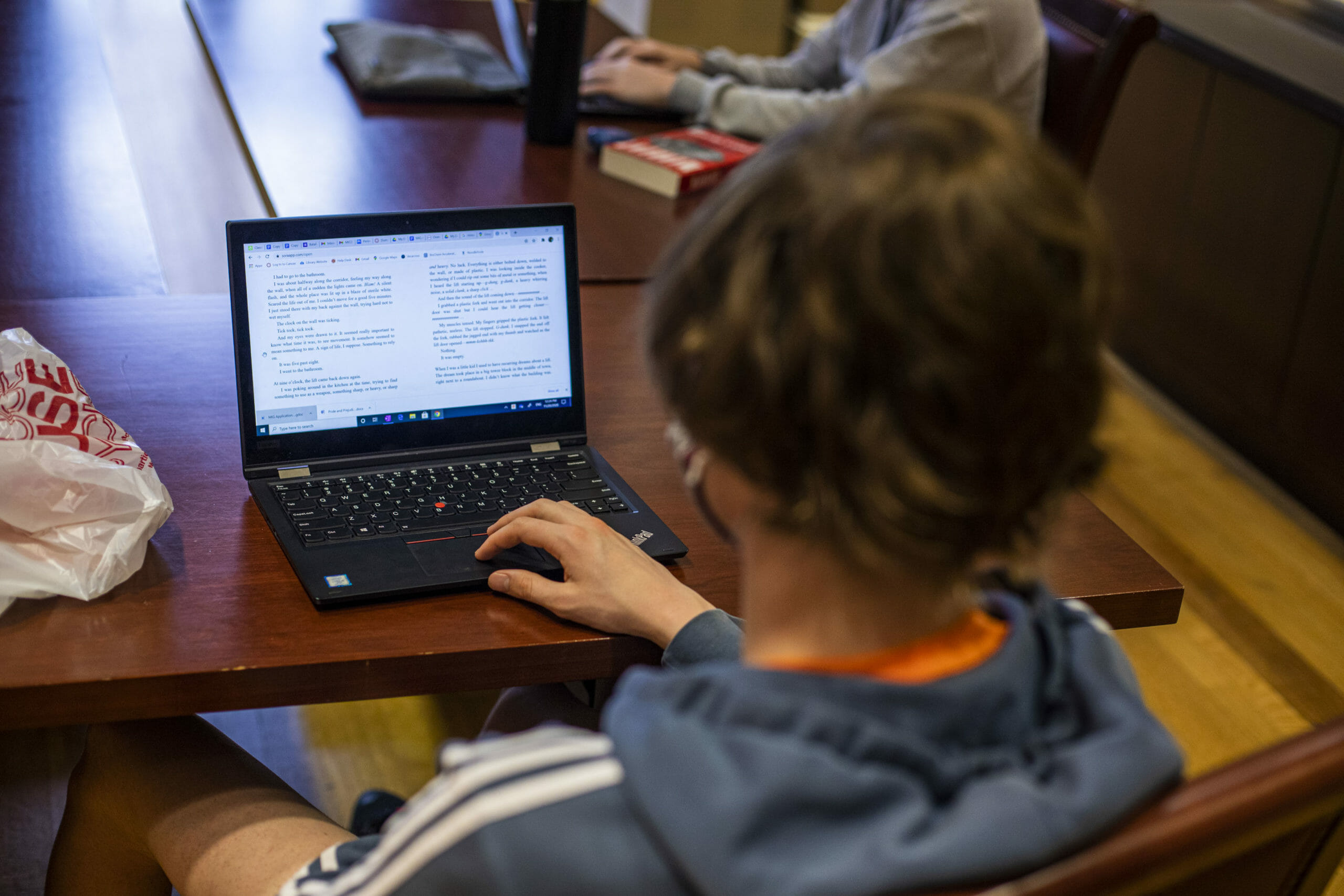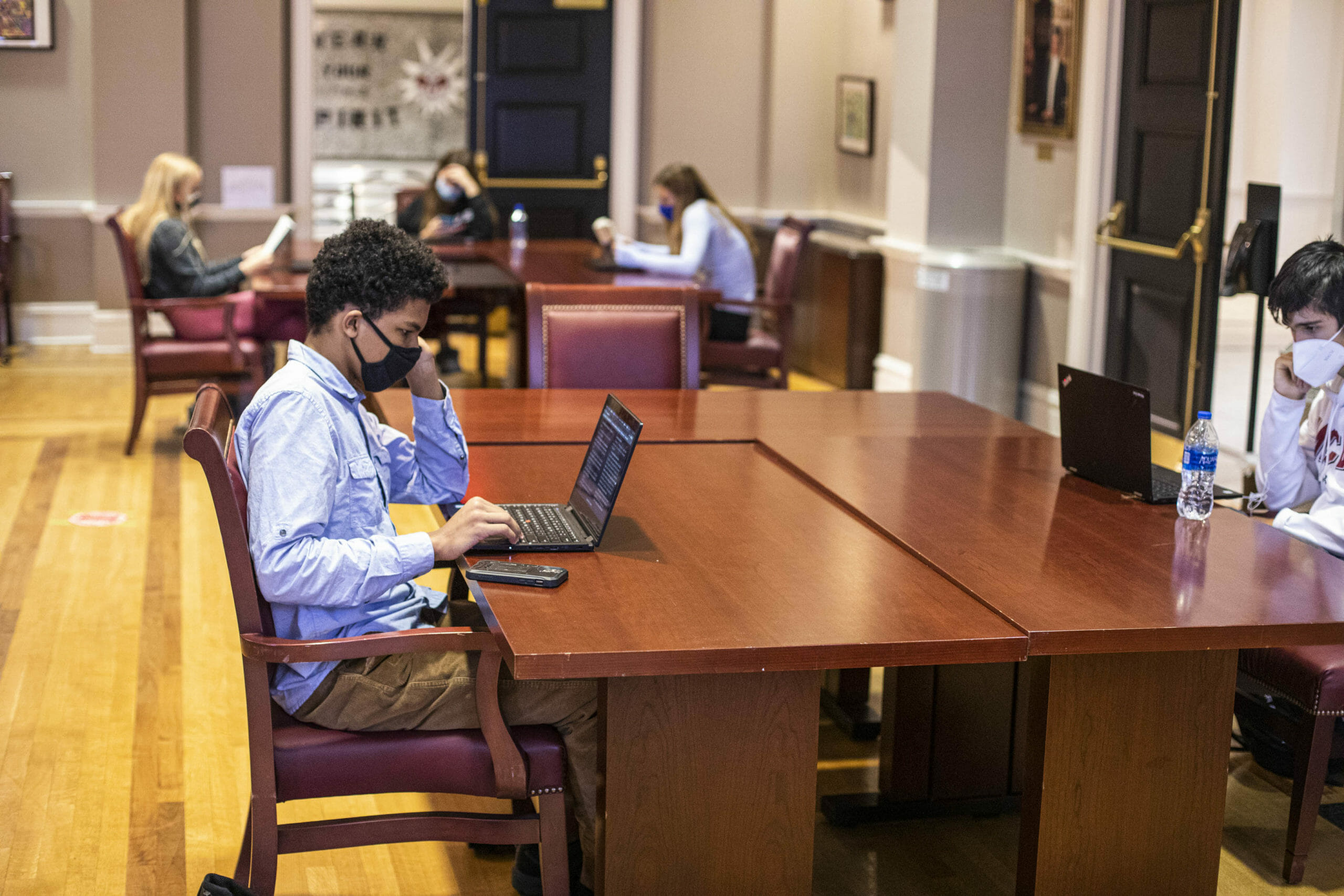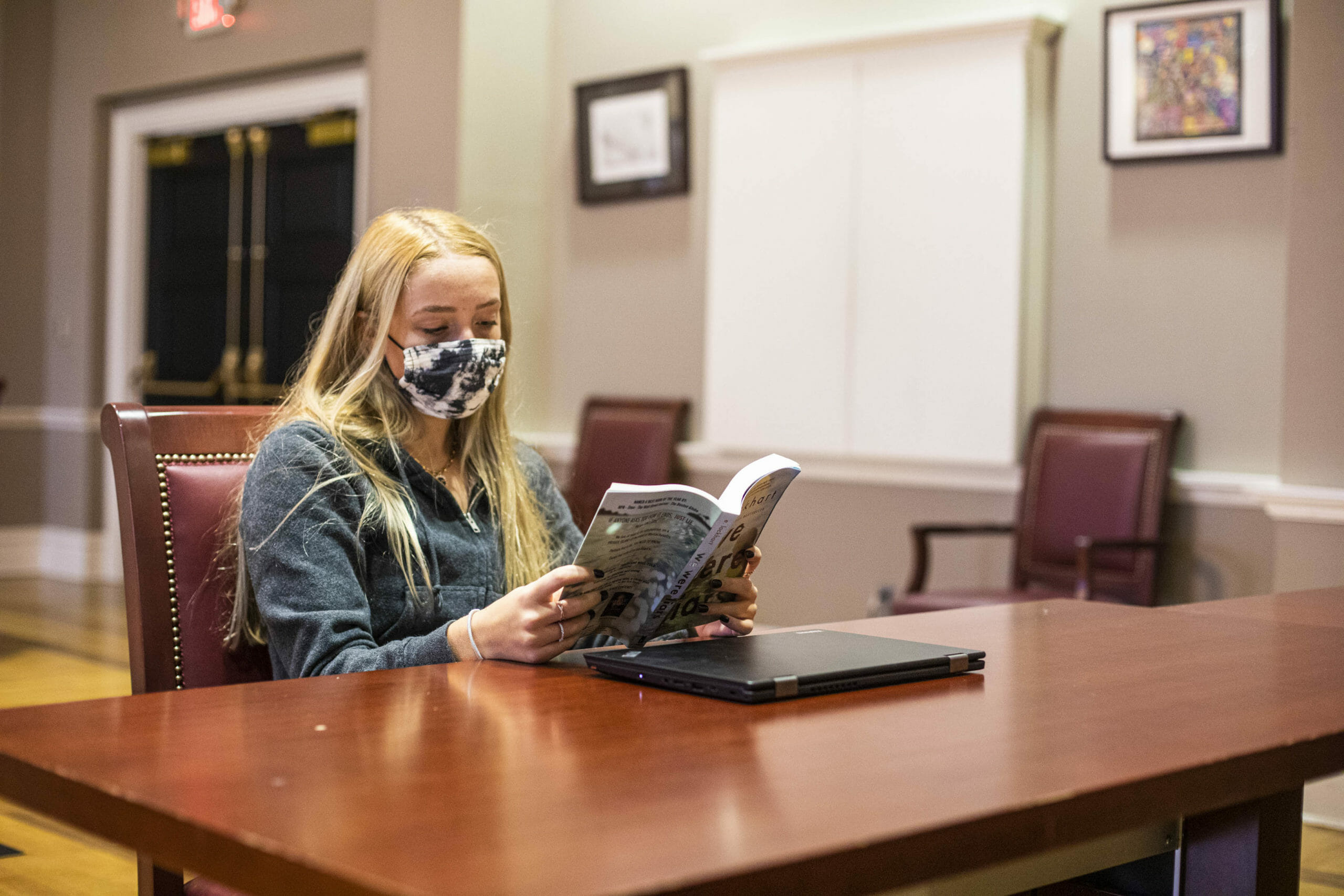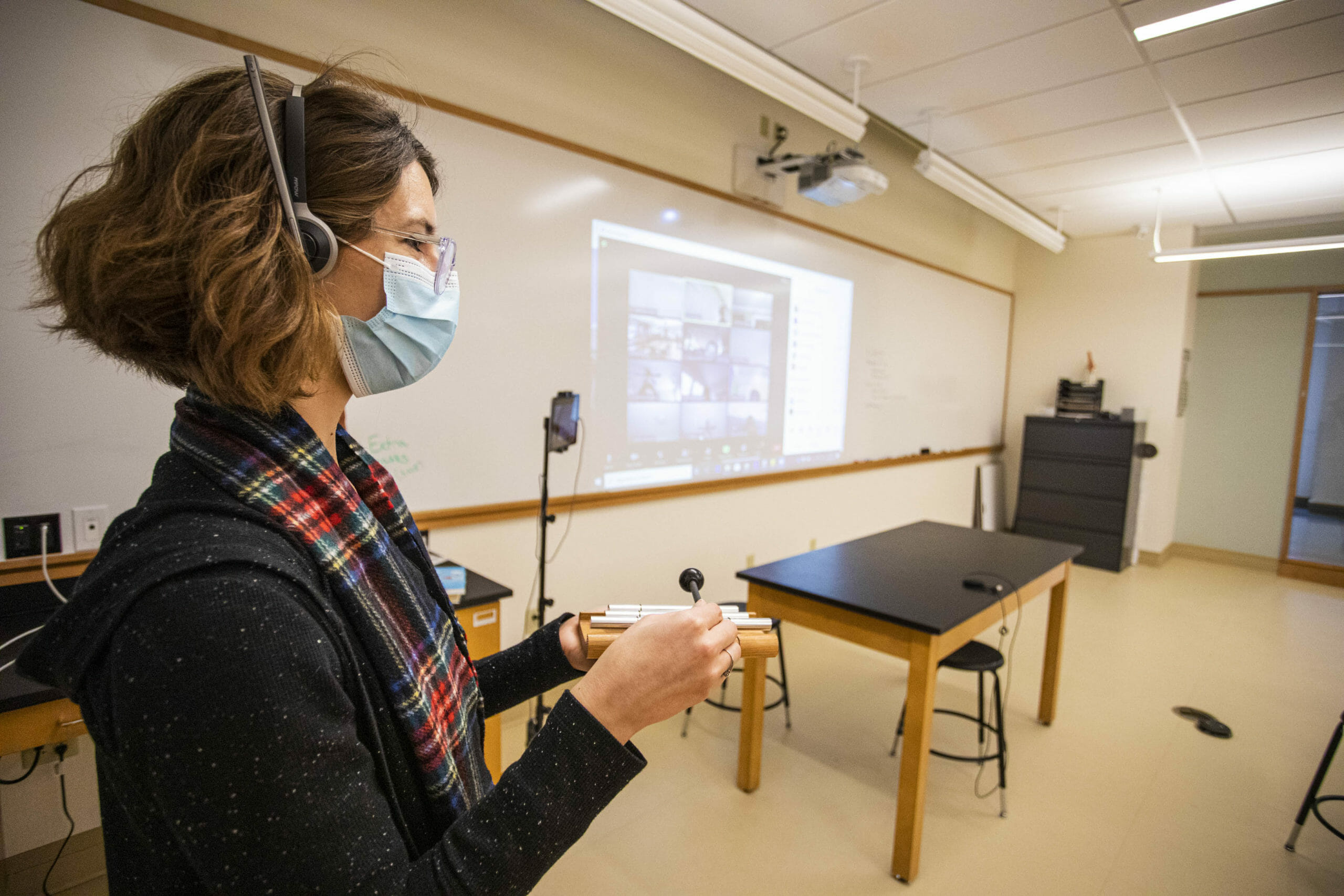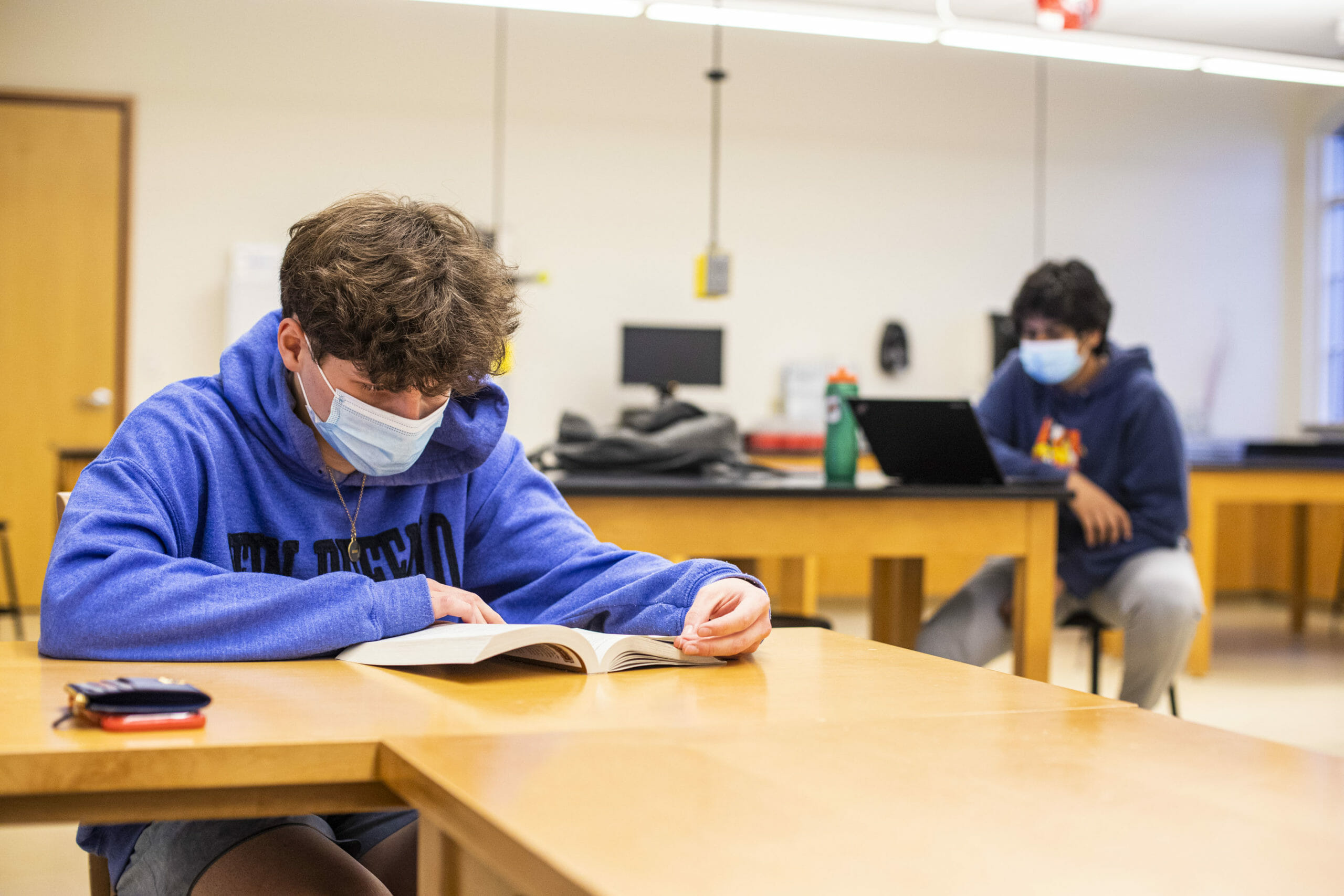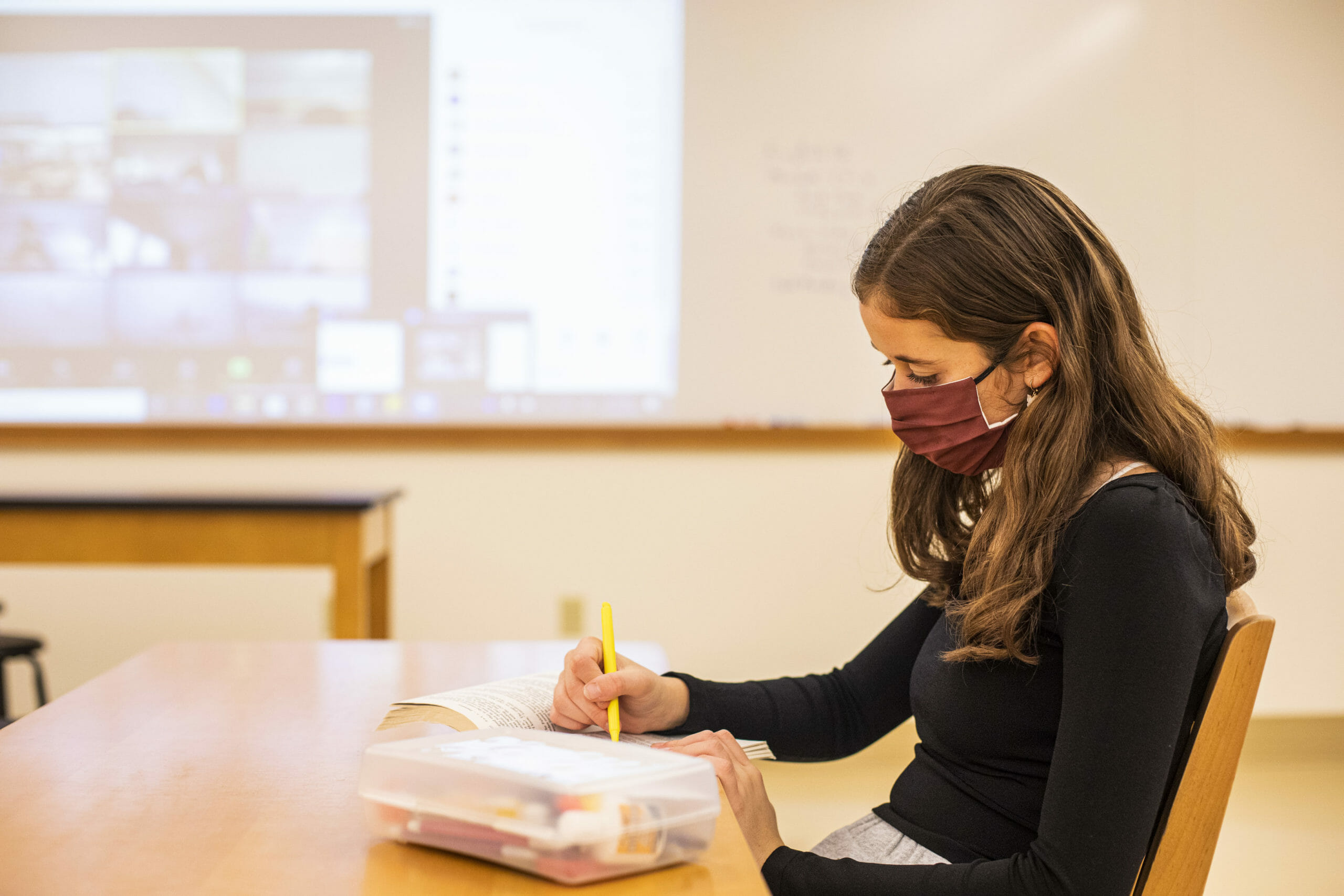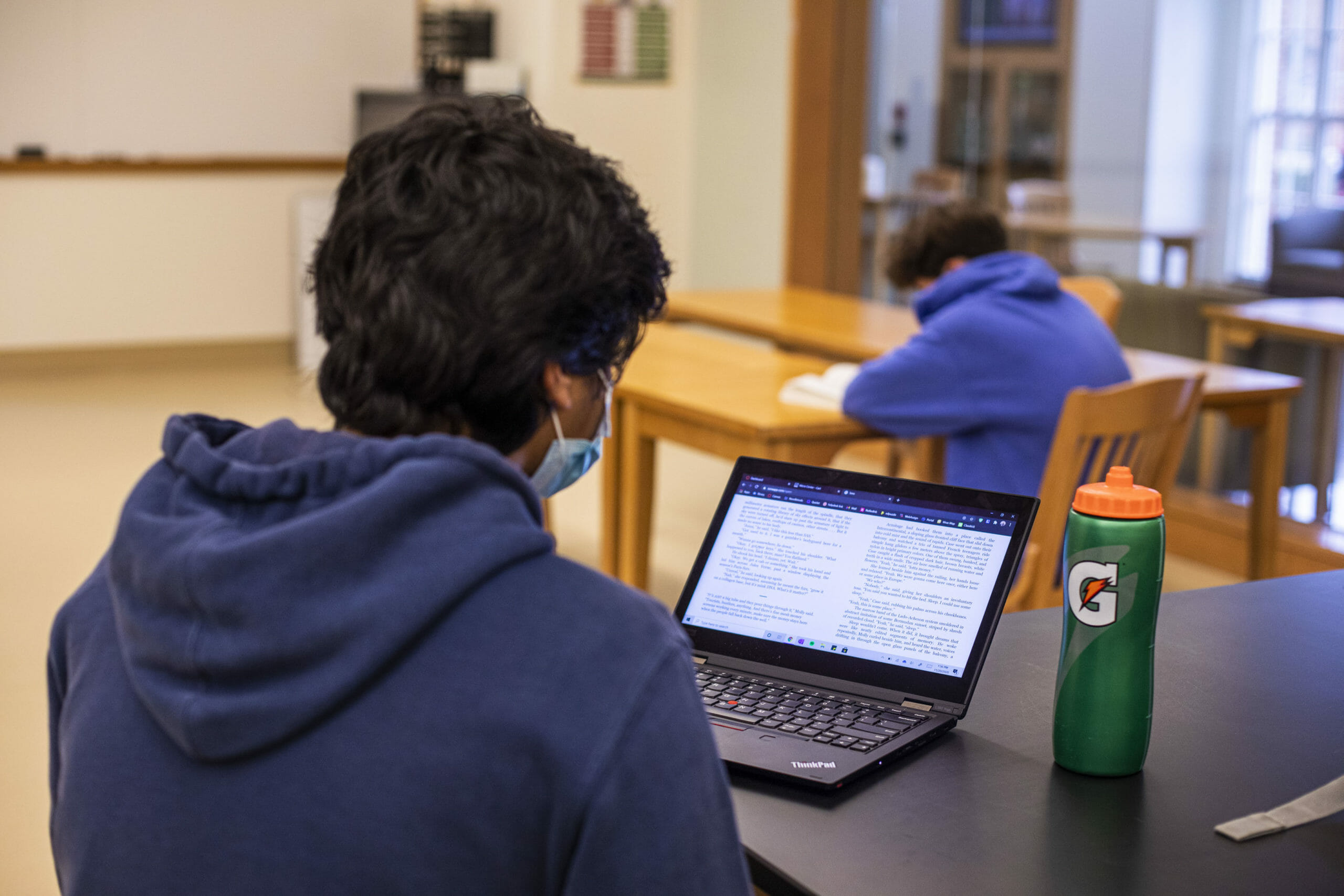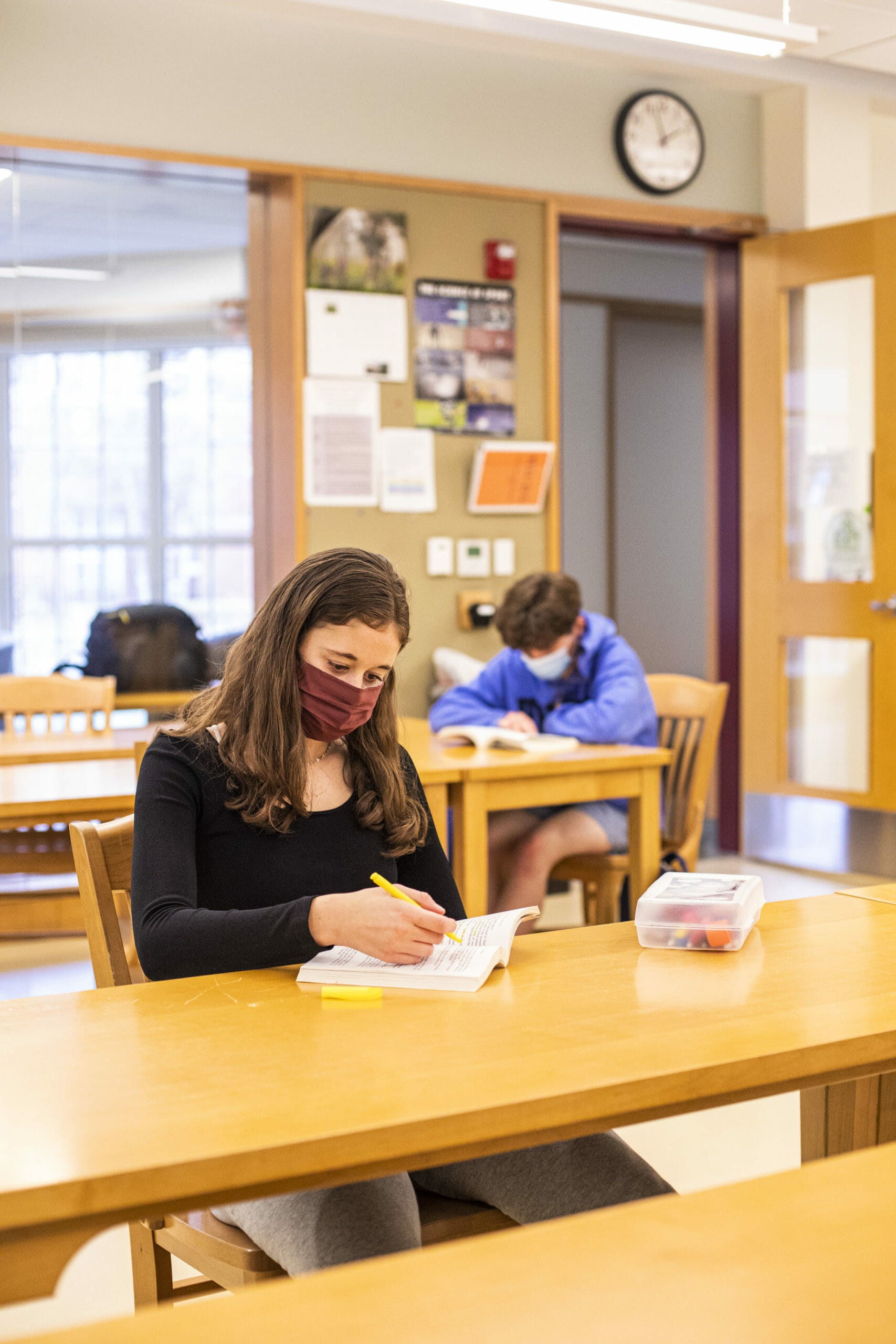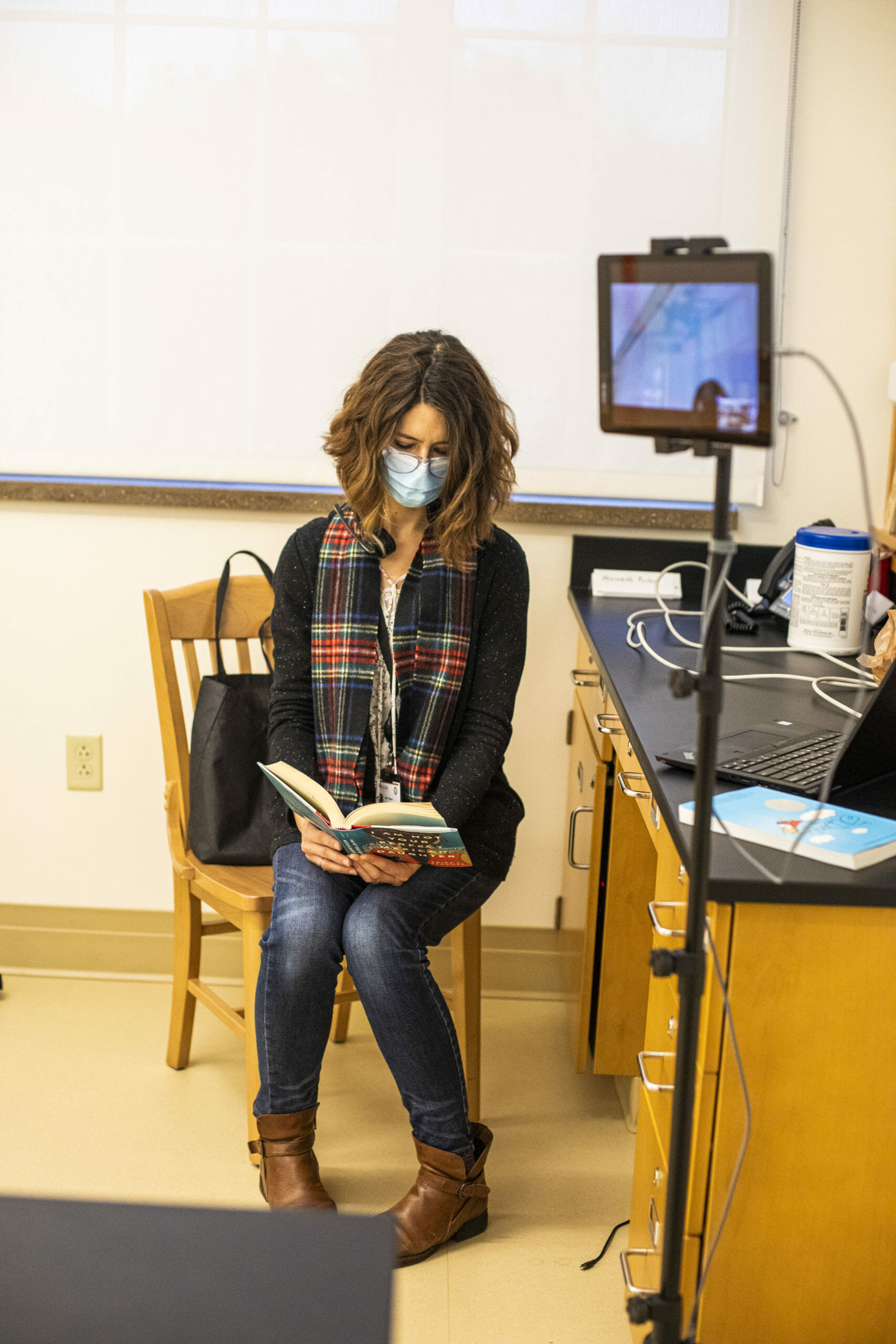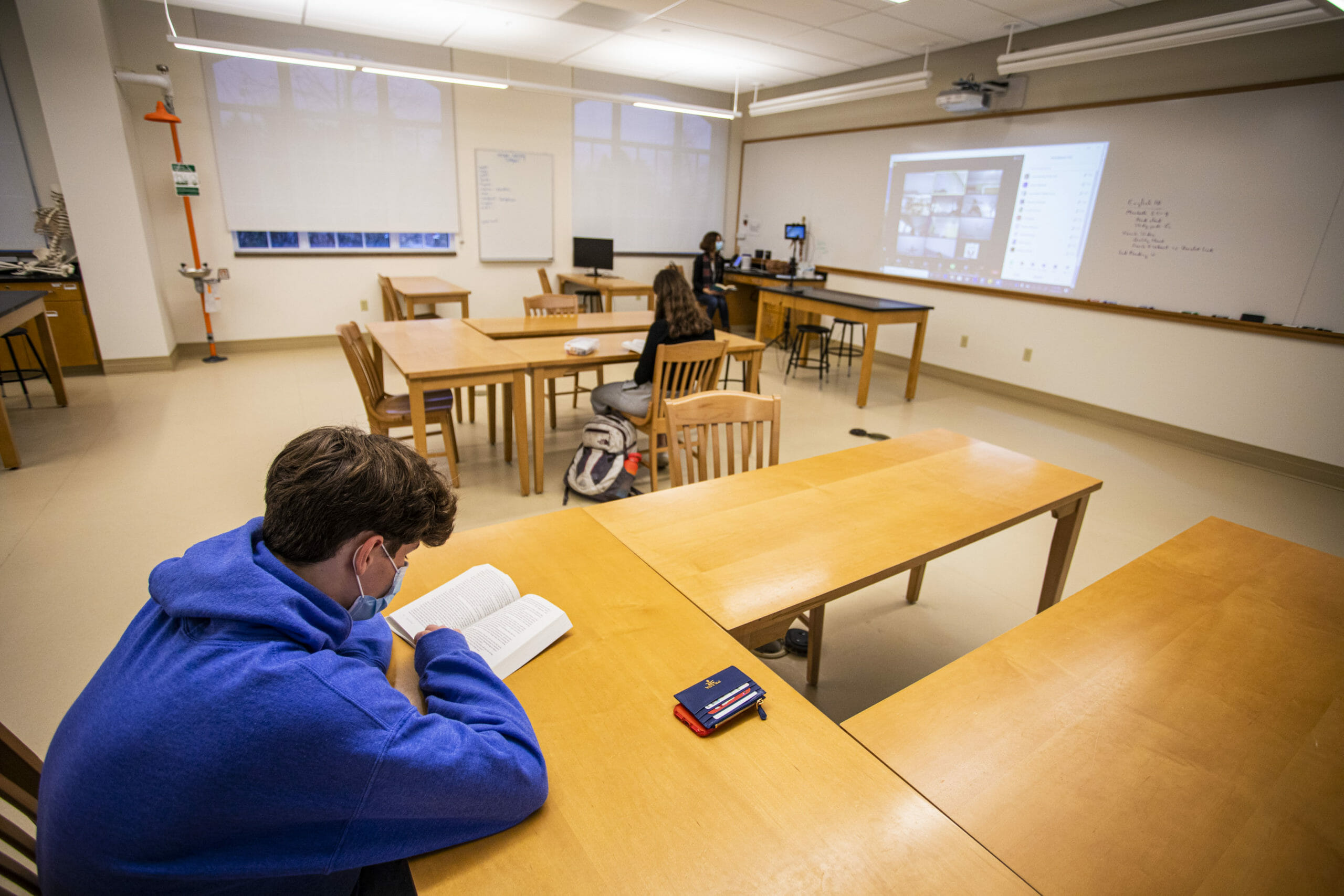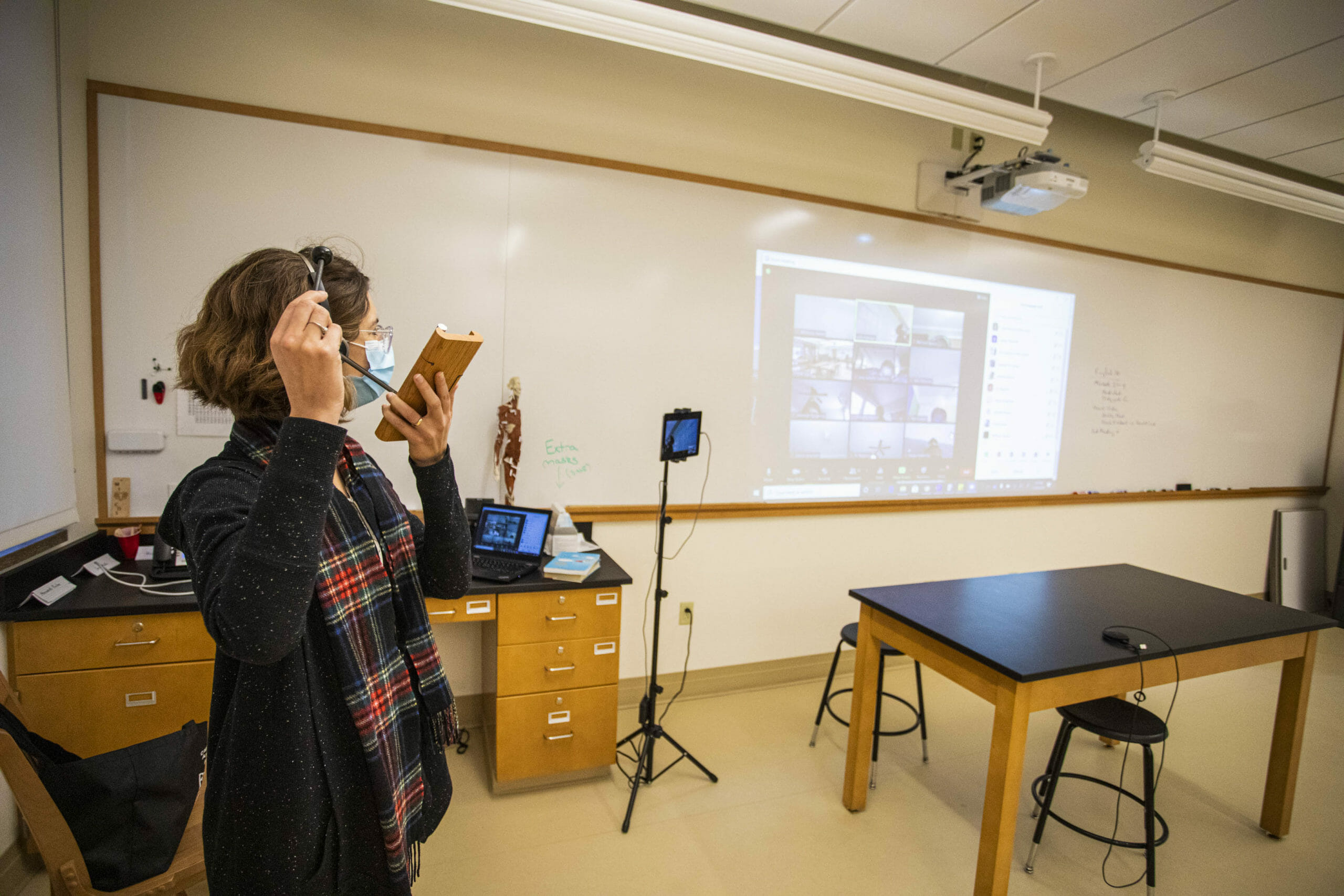Quiet, calm, turning a page: when we imagine what engagement and community look like, these are likely not the first images that come to mind. Yet this year, our 7th grade and 10th grade students, along with our 7th grade and 10th grade English teachers and librarians, are re-experiencing, witnessing, and sharing together the pleasure and power of independent reading.
Independent reading is an instructional practice that provides “time for students to read, access to books that represent a wide range of characters and experiences, and support within a reading community that includes teachers and students” (NCTE). This year, the MICDS English Department launched a cross-divisional Independent Reading Program. In 10th grade, every student spends 20 minutes of every long period reading. “If you look around the room—or across the gallery view in Zoom—as students read, you will see not only 17 different students but also 17 different books. Each student is reading a book of their choice,” Julia Hansen ’01, Upper School English Teacher, explains. “Some are reading physical books they found at home; others are reading physical books they borrowed from a library or ordered from a local bookstore; still others are reading ebooks through SORA (an online platform) on their computers or on Kindles. It shows our Department’s commitment to protecting time for students to read not for a grade but for themselves and in the company of other readers.”
The program complements the Department’s existing strengths with whole-class texts by providing students with the opportunity to choose their own books; where whole-class texts allow students to experience a shared text together, independent reading allows students to read books of their own choosing while still sharing reading time and recommendations with each other. Olivia Halverson, Middle School English Teacher, appreciates this combination: “Independent reading is an introspective activity, while also being an activity that is most successful when shared with others.” Rooted in research as well as love of reading, a community effort that in turn nurtures our community, the program aims to help students recognize themselves as readers, describe their reading identities, and reflect on and direct their lifelong reading journeys.
These aims are both new and not new. The English Department has long been committed to helping students cultivate a lifelong love of reading. Hansen remembers this from her time as an MICDS student, and seeing the school’s campus-wide signs identifying what staff and faculty are reading made her eager to return as a member of the faculty. What is new about the independent reading program is the Department’s intentional effort to dedicate class time to assessment-free reading, and to mentor students in reflecting on their reading lives. These changes are the result of a workshop that Hansen attended in Chicago. Led by Pernille Ripp, “Passionate Readers: The Art of Reaching and Engaging Every Child” focused on “reading identity,” on helping students understand themselves as readers. “The workshop gave me access to current research and best practices, for which I am grateful,” Hansen said. “What made it invaluable, though, was the way it sparked a significant change in my thinking. Acknowledging the many curricular obligations that teachers must meet, and the many curricular and extracurricular obligations that stand between students and their reading, Ripp addressed the issue of time: ‘If we take the time, we’ll have the time,’ she said. I learned here that while we cannot create more time for students to read, we can make choices about how to use our time together so that students know that their reading lives matter. I saw that one of the best choices I could make for my students was to protect that time so that they could read.” Upon returning from the workshop, Hansen collaborated with Katie Voss, Upper School Librarian, and Lynn Mittler, JK-12 Department Chair, to develop and test out an early version of the program with her juniors. Based on the work of Ripp, Nancie Atwell, Penny Kittle, Donalyn Miller, and other experts, the program has now been expanded to include all 10th and 7th grade English classes.
To prepare, teachers and librarians began over the summer by reflecting on their own reading identities. This involved writing about their formative reading experiences, current reading habits, how they talk about what they are reading with their students, and their goals for themselves as readers and reading teachers. Voss and alumna Mary Moore ’18 created recommended reading lists of Young Adult (YA) novels so that teachers could expand their familiarity with authors, titles, and genres that students might already be reading or might find engaging.
When classes began in August, teachers invited students into an intentionally scaffolded approach. Students completed a survey about their reading identities. After reflecting individually, students reflected collectively, sharing their observations about what makes reading joyful and what makes reading awful (an exercise adapted from Ripp). Students also learned about their “Reader’s Rights” (originally created by Daniel Pennac), the freedoms available to them and protected within independent reading time (such as “The right to abandon a book” or “The right to reread”). While there are times in English class where all students need to read the next chapter of Pride and Prejudice, independent reading time allows students a chance to choose what they read, to read at their own pace, to read in (mostly) their own ways, and to read for their own reasons.
To discover their reasons for reading, students explored and set reading goals. Teachers led discussions about how lifelong readers read for different reasons at different times, and how reading goals can change when readers change books, or simply when readers change themselves. Students were now ready to turn their attention to finding books! Annie Tsai Gomez, Middle School Librarian, and Voss visited classes and taught students how to navigate SORA. Conducting class visits over Zoom, Voss introduced students to different genres, and she “book talked” specific authors and titles within each genre. Students were encouraged to leave the virtual library with a list of books they might want to read and with at least one book selected that they would start reading in their next class.
Teachers typically dedicate the first 20 minutes of class to independent reading. Students close any tabs other than SORA, a dictionary, and their reading goal. They build their awareness of themselves as readers by, paradoxically, disappearing into their books. This also invites building shared class rituals. Hansen frequently says to her students, “I hope you feel seen in the way you want to be seen, challenged in the way you are ready to be challenged, and nourished in the way you most need to be nourished today.” Then she strikes a set of chimes and, if the class is meeting in person, total silence begins. If the class is meeting over Zoom, students read in individual breakout rooms and Hansen drops in on students to confer with them about their reading.
MICDS English teachers and librarians committed to this program for two striking reasons: integrity and joy. Supporting students in developing their reading lives apart from reading assessments appeals to David Terrell, Upper School English Teacher. “For high school students, assignments are largely a ‘do this or else’ proposition, but [independent reading] doesn’t acknowledge that paradigm, which elevates our students’ intellectual integrity,” Terrell said. For Heidi Lim, Upper School English Teacher, the program is also a chance to increase alignment between her beliefs and her actions. “I wanted to live what I preach—walk the walk—put my [valuable class time] where my mouth is,” Lim writes. “If [reading] is so important, why not allocate class time to it?” And along with this sense of increased integrity comes joy—the joy Celeste Prince, Upper School English Teacher finds in “giving kids the time to read and flow into class without any interruptions,” and the joy that Voss believes is at the heart of the program. “I see [independent reading] as a way to re-introduce the pure joy of reading back into our students’ lives,” she explains. “I often tell students that this experience is a gift from their teachers. It’s the gift of time and space, without any strings attached, to choose a book to read, and then just…read. There are lots of studies that tell us all of the ways that reading (and reading fiction in particular) benefits us. Reading fiction lowers stress, improves life satisfaction, and helps to develop empathy for others. I want our students to reap those benefits, especially now when life seems especially overwhelming, and [independent reading] gives them that opportunity.”
Student response has been overwhelmingly positive. In the words of Ranav Nandhi ’26, “I think [i]t is very fun[.] I love it.” Nicole Dai ’23 reflected on how independent reading at school both gave her time to read and encouraged her to keep reading outside of school. “Usually during the school year, I don’t spend a lot of time reading because I’m so caught up in doing my actual homework,” Dai remarked. “Recently, I’ve noticed myself spending any extra time I have over the weekend reading my independent reading book.” Students also appreciated the ways in which the practice provided what Hannah Morey ’23 called a peaceful moment. She said, “Independent reading gives me time to take a deep breath before continuing on with my day and this time has also helped me grow to be a better reader. Personally, I found myself wanting to read more often after getting a taste of my book during class. So far, I am already on my third book since the start of the school year and have enjoyed every minute of it.” Ishaan Handa ’23 confirms that independent reading “feels like a break” in the midst of the school day. “Even though I have been doing school remotely,” Handa remarked, “[independent reading] helps me ‘disconnect’ for a while and just enjoy a story of my choice and not worry about grades or assignments.”
As intended, the sustained practice has helped students not only read more books more frequently but also to become aware of their own reading identities and preferences. For Layla Gilbert ’26 this involves noticing patterns about her preferred book length as well as genre. “I like reading books that are less than 400 pages, but if it’s good enough, I’ll read it if it’s over 400,” Gilbert discovered. She also set (and met!) a reading goal to read one nonfiction book and one mystery book. “This was an important goal [for me],” Gilbert says, “because I was limiting myself to just reading fantasy and realistic fiction.” Aiyla Ahmad ’26 has set a similar goal for herself and is intentionally “trying to read books from many different genres because it really helps you to see the perspectives of other people and broaden your perspective and your knowledge about the world.”
Where some students focus on expanding what they are reading, other students experiment with how they are reading. Penny Chen ’23 uses independent reading time “to slow down and absorb the writing more.” Chen, a quick reader, set this goal for herself: “I think [slowing down] helps me realize the small details and help[s] me focus on what’s in front of me instead of the big picture all the time. It teaches me to be in the moment/present.” Here, a reading skill that Penny and her peers will learn through other parts of the English curriculum also contributes to the peace and mindfulness that Morey and Handa described.
For a program whose name highlights “independence,” the program has already fostered new forms of collaboration and interdependence between teachers and librarians, and between teachers and students. Tsai Gomez celebrates that students regularly email her with titles to add to the library’s collection; Maggie Dunson ’09, Middle School English Teacher, has started receiving recommendations from students for new books and genres that she has not read before. “[M]any of my students love manga,” writes Dunson, “and I have never really been exposed to that world. They recommended I start with My Hero Academia so guess what I just checked out from the library? Excited to read my first manga!” Halverson’s students make recommendations to each other in person and on a running Google Doc; in the words of Ahmad, “I believe that there is a book out there for everyone.”
Students’ engagement with books of choice has also encouraged faculty to reflect on their practices in general. “When I hear my students talk about the ways they relate to what they’re reading,” says Steven Collier, Upper School English Teacher, “I know that they’re benefitting not just as a reader but also in terms of their social and emotional learning.” This has reinforced for Collier the importance of making individual connections to the texts one reads. It has also inspired Lim to explore modeling more of her own reading practices for students, sharing out about the book she is currently reading and reflecting on her own reading journey. And Voss and Hansen both appreciate the way that collaborating with colleagues has become, in Voss’s words, “immensely personal” as the team has learned more about each other’s reading lives and reading journeys through the process of preparing to nurture students’ relationships with books.
All of this speaks to Mittler’s hope for the program: “I love the idea that we are (hopefully) cultivating a community of readers. With as busy as the students and adults are, there seems something so healthy about stopping for 20 minutes and reading. If we can turn students back onto reading and help them discover their own reading selves now, and in the future, I think we would serve them as well as when we help them become strong writers.” A gift of time to read on one’s own with others, our new program aspires to keep strengthening our independent readers and, in the process, our connections to each other.
